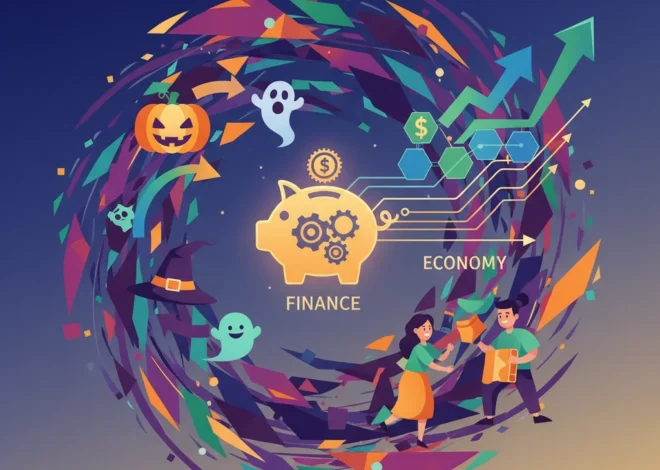
Navigating the Gauntlet: How Businesses Are Battling a Perfect Economic Storm and What It Means for Investors
On high streets and in industrial parks across the country, a quiet battle is being waged. It’s not a fight for market share or brand dominance, but for survival itself. Business owners, the lifeblood of our economy, are grappling with a dual-pronged assault: relentlessly rising costs and a chronic shortage of skilled staff. A recent report from the BBC highlights the personal stories behind the economic data, painting a vivid picture of the immense pressures facing entrepreneurs today. But this is more than just a collection of anecdotes; it’s a critical signal for the entire financial ecosystem, from Main Street to Wall Street.
This perfect storm is forcing a fundamental rethink of business models, operational strategies, and the very definition of corporate resilience. For investors, finance professionals, and business leaders, understanding the nuances of this struggle is not just an academic exercise—it’s essential for navigating the complex market dynamics ahead. In this deep dive, we will dissect the anatomy of these challenges, explore the innovative strategies businesses are deploying to overcome them, and analyze the profound implications for the stock market, the broader economy, and the future of investing.
The Anatomy of the Squeeze: A Multi-Front War on Margins
The phrase “rising costs” has become a ubiquitous headline, yet its simplicity belies a complex web of interconnected pressures. This isn’t a single wave crashing against businesses, but a relentless tide driven by multiple currents. To truly grasp the situation, we must break down the key components of this inflationary environment.
First, there are the direct input costs. Energy prices, while volatile, have remained stubbornly high, impacting everything from manufacturing processes to the electricity bill for a small café. Similarly, the cost of raw materials has surged due to a combination of post-pandemic supply chain snarls, geopolitical instability, and increased global demand. According to the UK’s Office for National Statistics, producer input price inflation, while having eased from its peak, remains a significant concern for businesses, indicating that the cost of materials and fuel is still a major factor (source).
Second, the very architecture of global trade has been reconfigured. The lean, just-in-time supply chains that defined decades of commerce proved brittle in the face of recent shocks. Businesses now face higher shipping costs, longer lead times, and the strategic necessity of diversifying their suppliers, all of which adds to the bottom line. This forces a difficult choice: absorb the costs and sacrifice profitability, or pass them on to consumers and risk a drop in demand.
Finally, the macroeconomic policy designed to combat this inflation has created its own set of challenges. Central banking institutions worldwide have raised interest rates to cool the economy, but this makes the cost of borrowing for businesses significantly higher. For companies relying on credit for expansion, inventory management, or even day-to-day operations, this tightening of finance can be suffocating.
The following table illustrates the primary cost pressures businesses are currently facing:
| Cost Pressure Category | Primary Drivers | Impact on Business |
|---|---|---|
| Energy & Utilities | Geopolitical events, supply constraints, green transition costs | Increased operational overhead, reduced profitability, pressure to invest in energy efficiency |
| Raw Materials & Goods | Global demand, supply chain disruption, commodity speculation | Higher cost of goods sold (COGS), inventory valuation challenges, need for product repricing |
| Labor & Staffing | Wage inflation, skills shortages, competition for talent | Increased payroll expenses, higher recruitment costs, potential loss of productivity |
| Financing & Capital | Central bank interest rate hikes, tighter lending standards | Higher debt servicing costs, difficulty securing loans for investment and growth |
The Isle of Man's 9.9% Wage Hike: A Microcosm of Global Economic Tensions
The Human Capital Conundrum: A Dearth of Talent in a Sea of Opportunity
Compounding the financial squeeze is a profound challenge on the human front. The “staffing pressures” mentioned in the BBC article are a symptom of a seismic shift in the labor market. The post-pandemic era has ushered in new expectations from employees regarding flexibility, purpose, and compensation, often termed “The Great Reshuffle.”
Businesses are now competing fiercely for a smaller pool of available, qualified talent. This dynamic fuels wage inflation, forcing companies to offer higher salaries and better benefits just to stay competitive. For small and medium-sized enterprises (SMEs), competing with the deeper pockets of large corporations becomes an uphill battle. The Federation of Small Businesses (FSB) has consistently reported that finding skilled staff is one of the biggest barriers to growth for their members (source).
This isn’t merely a numbers game; it’s also a skills mismatch. Rapid technological advancement means that the skills required today are different from those needed just five years ago. Sectors like digital marketing, data science, and green technology are experiencing acute shortages, forcing companies to either invest heavily in training or pay a premium for experienced professionals.
From Defense to Offense: Forging Resilience in the New Economy
Faced with this daunting landscape, innovative businesses are not just passively enduring; they are actively adapting. Their strategies offer a masterclass in resilience and provide a blueprint for navigating economic uncertainty.
1. Mastering Financial Agility with Fintech
The first line of defense is a deep understanding and control of company finance. Modern banking and financial technology (Fintech) are proving to be indispensable allies. Businesses are leveraging sophisticated software for real-time cash flow forecasting, scenario planning, and automated expense management. These tools move beyond simple accounting to provide predictive insights, allowing leaders to make proactive decisions rather than reactive ones. Fintech lenders also offer more flexible and accessible financing options compared to traditional banking, providing a crucial lifeline for SMEs needing to manage liquidity or seize growth opportunities.
2. Re-engineering Operations for a Volatile World
On the operational front, the focus is on building robust and flexible systems. This includes:
- Supply Chain Diversification: Moving away from single-source dependencies and exploring onshoring or near-shoring to reduce geopolitical risk and transportation costs.
- Technology Integration: Automating repetitive tasks to free up employees for higher-value work, using AI for demand forecasting, and implementing digital platforms to enhance customer experience.
- Sustainable Practices: Investing in energy-efficient equipment and processes not only reduces utility costs but also aligns with growing consumer and investor demand for sustainability. Some forward-thinking companies are even exploring emerging technologies like blockchain for enhancing supply chain transparency and security.
3. Innovating the Employee Value Proposition
To win the war for talent, businesses are redefining what it means to be a great employer. Beyond competitive salaries, they are offering flexible work arrangements, robust professional development programs, and a strong company culture. By investing in upskilling their existing workforce, companies can build the skills they need internally while fostering loyalty and reducing costly turnover.
The table below outlines some key adaptive strategies:
| Challenge Area | Adaptive Strategy | Key Benefit |
|---|---|---|
| Financial Pressure | Adopt Fintech for cash flow management; secure flexible credit lines. | Improved liquidity, better decision-making, financial resilience. |
| Operational Bottlenecks | Diversify suppliers; invest in automation and AI. | Reduced risk, increased efficiency, enhanced productivity. |
| Talent Shortages | Offer flexible work; invest in employee training and upskilling. | Improved attraction and retention, builds a future-proof workforce. |
The Air Fryer Economy: Why Free Tools Are Worthless Without Financial Literacy
The Investor’s Lens: Finding Opportunity in Adversity
For those involved in investing and trading, these microeconomic struggles have significant macroeconomic implications that ripple through the stock market. Understanding how different companies are responding to these pressures is crucial for identifying both risks and opportunities.
Sectors with high labor intensity and exposure to commodity price swings, such as traditional retail and manufacturing, are particularly vulnerable. Investors should scrutinize company earnings reports for any compression in profit margins and listen closely to management commentary on cost control and pricing power.
Conversely, companies that are part of the solution are poised for growth. This includes:
- Automation and Robotics Companies: As businesses seek to mitigate labor shortages and costs, the demand for automation technology will likely accelerate.
- Fintech and Enterprise Software (SaaS): Firms providing tools that enhance efficiency, improve financial management, and streamline operations are becoming essential services.
- Companies with Strong Pricing Power: Businesses with powerful brands, unique products, or dominant market positions are better able to pass on increased costs to consumers without losing market share.
The current economy demands a shift from passive, index-based investing to a more active, analytical approach. A deep dive into a company’s balance sheet, its supply chain strategy, and its investment in technology can reveal a resilience that is not always reflected in its top-line revenue growth. This is a stock-picker’s market, where quality and adaptability command a premium.
The 0 Billion Ripple Effect: Decoding Global Market Shifts from Defense to Finance
Conclusion: The Dawn of a More Resilient Economy
The challenges of rising costs and staffing shortages are more than just temporary headwinds; they are powerful catalysts for economic evolution. They are forcing businesses to become leaner, smarter, and more innovative. The pain is real, particularly for small businesses that lack the scale and resources of their larger counterparts. However, this period of intense pressure is also forging a new generation of resilient, adaptable, and technologically adept companies.
For leaders, the mandate is clear: embrace strategic finance, invest in your people, and build operational agility. For investors, the task is to look beyond the headlines and identify the companies that are not just surviving this economic gauntlet, but are using it as an opportunity to build a lasting competitive advantage. The landscape of our global economy is being reshaped in real-time, and those who understand the dynamics of this transformation will be best positioned for the prosperity that follows.


